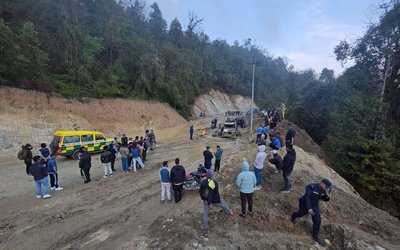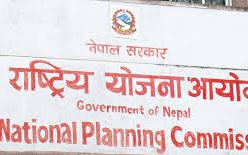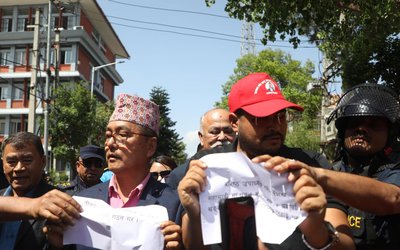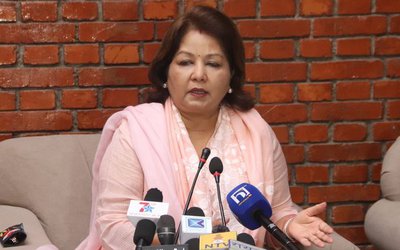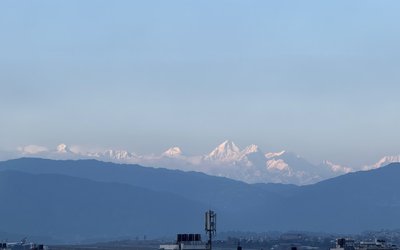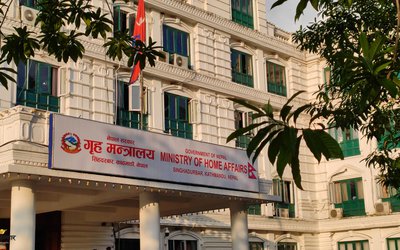
As Nepal is marking 16 days activism against gender based violence in all seven provinces, there are several cases of violence against women in Nepal recorded across the country.
Although the level of awareness has increased and legal remedy to punish perpetrator is there, nothing has changed as it was expected. Girl Child marriage continue in the rural Nepal so as the violence of incidents in urban areas.
Even the government is yet to arrest alleged criminals involved in raping and murdering Nirmala Panta of far west province in Nepal for three months. Even parents of 13 year old Panta started fasting to death. The situation of life of girls and women is bleak in Nepal.
According to Nepal demographic and Health Survey 2017, proportion of ever-partnered women aged 15-49 years experiencing intimate partner physical and/or sexual violence at least once in their lifetime.
The country is marking 16 Days of Activism against Gender-Based Violence from November 25 to December 10 with the theme ‘“Gender-Based Violence and harassment is unacceptable to us to raise public awareness and to mobilise people to put an end to violence against women.
The reports disclose that there hasn’t been any significant decline in incidents of violence against women.
Women’s experience of physical, sexual or emotional violence by spouse varies by ecological zone. Almost one-third of women in Tarai (32 per cent) report experiencing spousal physical, sexual or emotional violence, compared to less than 20 per cent women in the hills and mountains.
Global estimates published by WHO indicate that about 1 in 3 (35%) of women worldwide have experienced either physical and/or sexual intimate partner violence or non-partner sexual violence in their lifetime.
Most of this violence is intimate partner violence. Worldwide, almost one third (30%) of women who have been in a relationship report that they have experienced some form of physical and/or sexual violence by their intimate partner in their lifetime. Globally, as many as 38% of murders of women are committed by a male intimate partner.
Violence can negatively affect women’s physical, mental, sexual, and reproductive health, and may increase the risk of acquiring HIV in some settings.

Men are more likely to perpetrate violence if they have low education, a history of child maltreatment, exposure to domestic violence against their mothers, harmful use of alcohol, unequal gender norms including attitudes accepting of violence, and a sense of entitlement over women.
Women are more likely to experience intimate partner violence if they have low education, exposure to mothers being abused by a partner, abuse during childhood, and attitudes accepting violence, male privilege, and women’s subordinate status.
There is evidence that advocacy and empowerment counselling interventions, as well as home visitation are promising in preventing or reducing intimate partner violence against women.
The United Nations defines violence against women as "any act of gender-based violence that results in, or is likely to result in, physical, sexual, or mental harm or suffering to women, including threats of such acts, coercion or arbitrary deprivation of liberty, whether occurring in public or in private life."
Intimate partner violence refers to behaviour by an intimate partner or ex-partner that causes physical, sexual or psychological harm, including physical aggression, sexual coercion, psychological abuse and controlling behaviours.
Sexual violence is "any sexual act, attempt to obtain a sexual act, or other act directed against a person’s sexuality using coercion, by any person regardless of their relationship to the victim, in any setting. It includes rape, defined as the physically forced or otherwise coerced penetration of the vulva or anus with a penis, other body part or object."
Almost one third (30%) of all women who have been in a relationship have experienced physical and/or sexual violence by their intimate partner. The prevalence estimates of intimate partner violence range from 23.2% in high-income countries and 24.6% in the WHO Western Pacific region to 37% in the WHO Eastern Mediterranean region, and 37.7% in the WHO South-East Asia region.
Violence against women
Violence against women and girls (VAWG) is one of the most widespread, persistent and devastating human rights violations in our world today remains largely unreported due to the impunity, silence, stigma and shame surrounding it.
In general terms, it manifests itself in physical, sexual and psychological forms, encompassing: intimate partner violence (battering, psychological abuse, marital rape, femicide);
sexual violence and harassment (rape, forced sexual acts, unwanted sexual advances, child sexual abuse, forced marriage, street harassment, stalking, cyber- harassment); human trafficking (slavery, sexual exploitation); female genital mutilation; and child marriage.
To further clarify, the Declaration on the Elimination of Violence Against Women issued by the UN General Assembly in 1993, defines violence against women as “any act of gender-based violence that results in, or is likely to result in, physical, sexual or psychological harm or suffering to women, including threats of such acts, coercion or arbitrary deprivation of liberty, whether occurring in public or in private life.”
The adverse psychological, sexual and reproductive health consequences of VAWG affect women at all stages of their life. For example, early-set educational disadvantages not only represent the primary obstacle to universal schooling and the right to education for girls; down the line they are also to blame for restricting access to higher education and even translate into limited opportunities for women in the labour market.
While gender-based violence can happen to anyone, anywhere, some women and girls are particularly vulnerable - for instance, young girls and older women, women who identify as lesbian, bisexual, transgender or intersex, migrants and refugees, indigenous women and ethnic minorities, or women and girls living with HIV and disabilities, and those living through humanitarian crises.
Violence against women continues to be an obstacle to achieving equality, development, peace as well as to the fulfillment of women and girls’ human rights. All in all, the promise of the Sustainable Development Goals (SDGs) - to leave no one behind - cannot be fulfilled without putting an end to violence against women and girls.
Alarming Figures
1 in 3 women and girls experience physical or sexual violence in their lifetime, most frequently by an intimate partner
Only 52% of women married or in a union freely make their own decisions about sexual relations, contraceptive use and health care
Worldwide, almost 750 million women and girls alive today were married before their 18th birthday; while 200 million women and girls have undergone female genital mutilation (FGM)
1 in 2 women killed worldwide were killed by their partners or family in 2012; while only 1 out of 20 men were killed under similar circumstances
71% of all human trafficking victims worldwide are women and girls, and 3 out of 4 of these women and girls are sexually exploited
Violence against women is as serious a cause of death and incapacity among women of reproductive age as cancer, and a greater cause of ill health than traffic accidents and malaria combined.
Global Action: Orange the World
The 25th of every month has been designated as Orange Day by the UN Women campaign Say No, UNiTE launched in 2009 to mobilize civil society, activists, governments and the UN system in order amplify the impact of the UN Secretary-General’s campaign, UNiTE to End Violence against Women. Participants the world over are encouraged to wear a touch of orange in solidarity with the cause - the colour symbolizes a brighter future and a world free from violence against women and girls.
The 2018 theme is Orange the World: #HearMeToo and like previous editions, the date marks the launch of 16 days of activism that will conclude on 10 December 2018, International Human Rights Day.
.
- India Supported Construction Of Four Schools In Nuwakot
- Mar 19, 2021
- Nepal Denies Permission For Third Phase Trial Of Vaccine Against COVID-19
- Aug 31, 2020
- Messi Can Only Cancel Barcelona Contract If €700 Million Release Clause Is Paid, La Liga Confirms
- Aug 31, 2020
- India To Carry Out Study On Kathmandu-Raksaul Railway
- Aug 28, 2020
- COVID-19: 1,351 Personal Of Nepal Police Infected
- Aug 28, 2020
